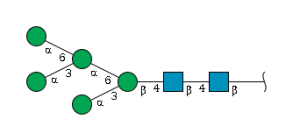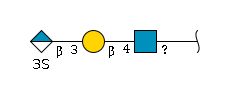Testhyperlink123: Difference between revisions
Jump to navigation
Jump to search
Guptareeya53 (talk | contribs) (test page save) |
Guptareeya53 (talk | contribs) No edit summary |
||
| Line 1: | Line 1: | ||
===High mannose=== | |||
[[File:G55220VL.png|thumb|G55220VL]] | |||
'''term (main_entry)''' : High mannose <br> | |||
'''glycan_dictionary_accession''' : GSD000108 <br> | |||
'''glytoucan_accession ''' : [https://www.glygen.org/glycan/G55220VL G55220VL] <br> | |||
'''term_in_sentence''' : Each glycoform contained a number of peaks differing by 162 Da indicating heterogeneity and suggesting the presence of high-mannose sugars.[PMID:<a href="https://pubmed.ncbi.nlm.nih.gov/<a href="https://pubmed.ncbi.nlm.nih.gov/11258925">11258925</a>"><a href="https://pubmed.ncbi.nlm.nih.gov/11258925">11258925</a></a>] <br> | |||
'''publication''' : <a href="https://pubmed.ncbi.nlm.nih.gov/<a href="https://pubmed.ncbi.nlm.nih.gov/11258925">11258925</a>"><a href="https://pubmed.ncbi.nlm.nih.gov/11258925">11258925</a></a>|<a href="https://pubmed.ncbi.nlm.nih.gov/17956937">17956937</a>|<a href="https://pubmed.ncbi.nlm.nih.gov/2059624">2059624</a>|<a href="https://pubmed.ncbi.nlm.nih.gov/2065054">2065054</a>|<a href="https://pubmed.ncbi.nlm.nih.gov/26791533">26791533</a>|<a href="https://pubmed.ncbi.nlm.nih.gov/4077844">4077844</a>|<a href="https://pubmed.ncbi.nlm.nih.gov/7780197">7780197</a>|<a href="https://pubmed.ncbi.nlm.nih.gov/9136890">9136890</a>|<a href="https://pubmed.ncbi.nlm.nih.gov/30659065">30659065</a>|<a href="https://pubmed.ncbi.nlm.nih.gov/30075362">30075362</a>|<a href="https://pubmed.ncbi.nlm.nih.gov/21421994">21421994</a>|<a href="https://pubmed.ncbi.nlm.nih.gov/31076349">31076349</a>|<a href="https://pubmed.ncbi.nlm.nih.gov/29738673">29738673</a>|<a href="https://pubmed.ncbi.nlm.nih.gov/29508223">29508223</a>|<a href="https://pubmed.ncbi.nlm.nih.gov/26747427">26747427</a>|<a href="https://pubmed.ncbi.nlm.nih.gov/30634645">30634645</a>|<a href="https://pubmed.ncbi.nlm.nih.gov/23007868">23007868</a>|<a href="https://pubmed.ncbi.nlm.nih.gov/29051951">29051951</a>|<a href="https://pubmed.ncbi.nlm.nih.gov/24549150">24549150</a>|<a href="https://pubmed.ncbi.nlm.nih.gov/<a href="https://pubmed.ncbi.nlm.nih.gov/12417032">12417032</a>"><a href="https://pubmed.ncbi.nlm.nih.gov/12417032">12417032</a></a>|<a href="https://pubmed.ncbi.nlm.nih.gov/26724786">26724786</a>|<a href="https://pubmed.ncbi.nlm.nih.gov/26956389">26956389</a>|<a href="https://pubmed.ncbi.nlm.nih.gov/26493153">26493153</a>|<a href="https://pubmed.ncbi.nlm.nih.gov/31102532">31102532</a>|<a href="https://pubmed.ncbi.nlm.nih.gov/29673624">29673624</a>|<a href="https://pubmed.ncbi.nlm.nih.gov/8348230">8348230</a>|<a href="https://pubmed.ncbi.nlm.nih.gov/25586968">25586968</a>|<a href="https://pubmed.ncbi.nlm.nih.gov/24975601">24975601</a>|<a href="https://pubmed.ncbi.nlm.nih.gov/29803109">29803109</a>|<a href="https://pubmed.ncbi.nlm.nih.gov/28465212">28465212</a>|<a href="https://pubmed.ncbi.nlm.nih.gov/25776945">25776945</a>|<a href="https://pubmed.ncbi.nlm.nih.gov/30151520">30151520</a>|<a href="https://pubmed.ncbi.nlm.nih.gov/21097542">21097542</a>|<a href="https://pubmed.ncbi.nlm.nih.gov/24326091">24326091</a>|<a href="https://pubmed.ncbi.nlm.nih.gov/27995699">27995699</a>|<a href="https://pubmed.ncbi.nlm.nih.gov/26003537">26003537</a>|<a href="https://pubmed.ncbi.nlm.nih.gov/6722291">6722291</a>|<a href="https://pubmed.ncbi.nlm.nih.gov/2925680">2925680</a>|<a href="https://pubmed.ncbi.nlm.nih.gov/25565276">25565276</a>|<a href="https://pubmed.ncbi.nlm.nih.gov/21460211">21460211</a>|<a href="https://pubmed.ncbi.nlm.nih.gov/25196214">25196214</a>|<a href="https://pubmed.ncbi.nlm.nih.gov/27387600">27387600</a>|<a href="https://pubmed.ncbi.nlm.nih.gov/22373601">22373601</a>|<a href="https://pubmed.ncbi.nlm.nih.gov/3729933">3729933</a>|<a href="https://pubmed.ncbi.nlm.nih.gov/16423983">16423983</a>|<a href="https://pubmed.ncbi.nlm.nih.gov/24174266">24174266</a>|<a href="https://pubmed.ncbi.nlm.nih.gov/30605318">30605318</a>|<a href="https://pubmed.ncbi.nlm.nih.gov/32371950">32371950</a><br> | |||
'''definition''' : An N-linked oligosaccharide that possesses between five and nine mannose residues attached to the chitobiose [(GlcNAc)2] core. [CHEBI:5717] None of the Man residues are substituted with any monosaccharide other than Man . <br> | |||
'''term_xref''' : GTC:G55220VL|CID:<a href="https://pubmed.ncbi.nlm.nih.gov/70698382">70698382</a>|CHEBI:71514<br> | |||
'''synonyms''' : oligomannose, high-mannose, oligomannose-type <br> | |||
'''function''' : Involved in promotion of protein folding in ER. [PMID:<a href="https://pubmed.ncbi.nlm.nih.gov/<a href="https://pubmed.ncbi.nlm.nih.gov/12417032">12417032</a>"><a href="https://pubmed.ncbi.nlm.nih.gov/12417032">12417032</a></a>].|High Man glycans are enriched at cell surface during apoptosis.[PMID: <a href="https://pubmed.ncbi.nlm.nih.gov/17516205">17516205</a>] <br> | |||
'''disease_associations''' : Relative abundance changes in multiple CDGs [PMID: <a href="https://pubmed.ncbi.nlm.nih.gov/30770376">30770376</a>][PMID: <a href="https://pubmed.ncbi.nlm.nih.gov/28484880">28484880</a>] <br> | |||
'''wikipedia''' : <br> | |||
'''essentials_of_glycobiology''' : [https://www.ncbi.nlm.nih.gov/books/NBK453033/ Chapter 17] <br> | |||
===HNK-1=== | |||
[[File:G54406UD.png|thumb|G54406UD]] | |||
'''term (main_entry)''' : HNK-1 <br> | |||
'''glycan_dictionary_accession''' : GSD000109 <br> | |||
'''glytoucan_accession ''' : [https://www.glygen.org/glycan/G54406UD G54406UD] <br> | |||
'''term_in_sentence''' : The human natural killer-1 (HNK-1) carbohydrate, a unique trisaccharide possessing sulfated glucuronic acid in a non-reducing terminus (HSO3-3GlcAß1-3Galß1-4GlcNAc-), is highly expressed in the nervous system and its spatiotemporal expression is strictly regulated.[PMID:<a href="https://pubmed.ncbi.nlm.nih.gov/<a href="https://pubmed.ncbi.nlm.nih.gov/28709864">28709864</a>"><a href="https://pubmed.ncbi.nlm.nih.gov/28709864">28709864</a></a>] <br> | |||
'''publication''' : <a href="https://pubmed.ncbi.nlm.nih.gov/<a href="https://pubmed.ncbi.nlm.nih.gov/28709864">28709864</a>"><a href="https://pubmed.ncbi.nlm.nih.gov/28709864">28709864</a></a>|<a href="https://pubmed.ncbi.nlm.nih.gov/31738061">31738061</a>|<a href="https://pubmed.ncbi.nlm.nih.gov/26738850">26738850</a>|<a href="https://pubmed.ncbi.nlm.nih.gov/30306736">30306736</a>|<a href="https://pubmed.ncbi.nlm.nih.gov/11070366">11070366</a>|<a href="https://pubmed.ncbi.nlm.nih.gov/20855890">20855890</a>|<a href="https://pubmed.ncbi.nlm.nih.gov/18024472">18024472</a>|<a href="https://pubmed.ncbi.nlm.nih.gov/22669261">22669261</a>|<a href="https://pubmed.ncbi.nlm.nih.gov/19729452">19729452</a>|<a href="https://pubmed.ncbi.nlm.nih.gov/19796667">19796667</a>|<a href="https://pubmed.ncbi.nlm.nih.gov/26850637">26850637</a>|<a href="https://pubmed.ncbi.nlm.nih.gov/11769463">11769463</a>|<a href="https://pubmed.ncbi.nlm.nih.gov/18263654">18263654</a>|<a href="https://pubmed.ncbi.nlm.nih.gov/15843379">15843379</a>|<a href="https://pubmed.ncbi.nlm.nih.gov/26659409">26659409</a>|<a href="https://pubmed.ncbi.nlm.nih.gov/9003039">9003039</a>|<a href="https://pubmed.ncbi.nlm.nih.gov/22087768">22087768</a>|<a href="https://pubmed.ncbi.nlm.nih.gov/21771787">21771787</a>|<a href="https://pubmed.ncbi.nlm.nih.gov/15173636">15173636</a>|<a href="https://pubmed.ncbi.nlm.nih.gov/9210489">9210489</a>|<a href="https://pubmed.ncbi.nlm.nih.gov/15258996">15258996</a>|<a href="https://pubmed.ncbi.nlm.nih.gov/17924534">17924534</a>|<a href="https://pubmed.ncbi.nlm.nih.gov/26382082">26382082</a>|<a href="https://pubmed.ncbi.nlm.nih.gov/16171882">16171882</a>|<a href="https://pubmed.ncbi.nlm.nih.gov/18802400">18802400</a>|<a href="https://pubmed.ncbi.nlm.nih.gov/9800516">9800516</a>|<a href="https://pubmed.ncbi.nlm.nih.gov/7504418">7504418</a>|<a href="https://pubmed.ncbi.nlm.nih.gov/11891229">11891229</a>|<a href="https://pubmed.ncbi.nlm.nih.gov/15232286">15232286</a>|<a href="https://pubmed.ncbi.nlm.nih.gov/9013478">9013478</a>|<a href="https://pubmed.ncbi.nlm.nih.gov/21621858">21621858</a>|<a href="https://pubmed.ncbi.nlm.nih.gov/11677051">11677051</a>|<a href="https://pubmed.ncbi.nlm.nih.gov/18668221">18668221</a>|<a href="https://pubmed.ncbi.nlm.nih.gov/11414798">11414798</a>|<a href="https://pubmed.ncbi.nlm.nih.gov/19265195">19265195</a>|<a href="https://pubmed.ncbi.nlm.nih.gov/8982638">8982638</a>|<a href="https://pubmed.ncbi.nlm.nih.gov/8798480">8798480</a>|<a href="https://pubmed.ncbi.nlm.nih.gov/28403522">28403522</a>|<a href="https://pubmed.ncbi.nlm.nih.gov/17935701">17935701</a>|<a href="https://pubmed.ncbi.nlm.nih.gov/1691305">1691305</a>|<a href="https://pubmed.ncbi.nlm.nih.gov/10998116">10998116</a>|<a href="https://pubmed.ncbi.nlm.nih.gov/9364602">9364602</a>|<a href="https://pubmed.ncbi.nlm.nih.gov/7528651">7528651</a>|<a href="https://pubmed.ncbi.nlm.nih.gov/12472892">12472892</a>|<a href="https://pubmed.ncbi.nlm.nih.gov/21176892">21176892</a>|<a href="https://pubmed.ncbi.nlm.nih.gov/28416698">28416698</a>|<a href="https://pubmed.ncbi.nlm.nih.gov/19389918">19389918</a>|<a href="https://pubmed.ncbi.nlm.nih.gov/28427937">28427937</a>|<a href="https://pubmed.ncbi.nlm.nih.gov/25450311">25450311</a> <br> | |||
'''definition''' : An amino trisaccharide consisting of a 3-O-sulfo-β-D-glucuronic acid residue, a D-galactosyl residue and an N-acetyl-D-glucosamine residue (at the reducing end) in a linear sequence.[CHEBI:60322] <br> | |||
'''term_xref''' : GTC:G54406UD|GlycoEpitope:EP0001|CID:<a href="https://pubmed.ncbi.nlm.nih.gov/46906103">46906103</a>|CHEBI:60322|GlycoMotif:GGM.000058 <br> | |||
'''synonyms''' : HNK-1 carbohydrate epitope| CD57|HNK-1 antigen <br> | |||
'''function''' : learning and memory[GlycoEpitope:EP0001]|neural crest cell migration[GlycoEpitope:EP0001]|neurite extension[GlycoEpitope:EP0001]|neuron-astrocyte adhesion[GlycoEpitope:EP0001] <br> | |||
'''disease_associations''' : schizophrenia-like psychosis[GlycoEpitope:EP0001]|neuropathy[GlycoEpitope:EP0001]|exfoliation syndrome[GlycoEpitope:EP0001]|secondary cataract[GlycoEpitope:EP0001] <br> | |||
'''wikipedia''' : https://en.wikipedia.org/wiki/N-linked_glycosylation <br> | |||
'''essentials_of_glycobiology''' : [https://www.ncbi.nlm.nih.gov/books/NBK453033/ Chapter 17]<br> | |||
=== | |||
[[File: | |||
'''term (main_entry)''' : | |||
'''glycan_dictionary_accession''' : | |||
'''glytoucan_accession ''' : [https://www.glygen.org/glycan/ | |||
'''term_in_sentence''' : | |||
'''publication''' : | |||
'''definition''' : | |||
''' | |||
''' | |||
Revision as of 16:14, 29 March 2023
High mannose

term (main_entry) : High mannose
glycan_dictionary_accession : GSD000108
glytoucan_accession : G55220VL
term_in_sentence : Each glycoform contained a number of peaks differing by 162 Da indicating heterogeneity and suggesting the presence of high-mannose sugars.[PMID:<a href="https://pubmed.ncbi.nlm.nih.gov/<a href="https://pubmed.ncbi.nlm.nih.gov/11258925">11258925</a>"><a href="https://pubmed.ncbi.nlm.nih.gov/11258925">11258925</a></a>]
publication : <a href="https://pubmed.ncbi.nlm.nih.gov/<a href="https://pubmed.ncbi.nlm.nih.gov/11258925">11258925</a>"><a href="https://pubmed.ncbi.nlm.nih.gov/11258925">11258925</a></a>|<a href="https://pubmed.ncbi.nlm.nih.gov/17956937">17956937</a>|<a href="https://pubmed.ncbi.nlm.nih.gov/2059624">2059624</a>|<a href="https://pubmed.ncbi.nlm.nih.gov/2065054">2065054</a>|<a href="https://pubmed.ncbi.nlm.nih.gov/26791533">26791533</a>|<a href="https://pubmed.ncbi.nlm.nih.gov/4077844">4077844</a>|<a href="https://pubmed.ncbi.nlm.nih.gov/7780197">7780197</a>|<a href="https://pubmed.ncbi.nlm.nih.gov/9136890">9136890</a>|<a href="https://pubmed.ncbi.nlm.nih.gov/30659065">30659065</a>|<a href="https://pubmed.ncbi.nlm.nih.gov/30075362">30075362</a>|<a href="https://pubmed.ncbi.nlm.nih.gov/21421994">21421994</a>|<a href="https://pubmed.ncbi.nlm.nih.gov/31076349">31076349</a>|<a href="https://pubmed.ncbi.nlm.nih.gov/29738673">29738673</a>|<a href="https://pubmed.ncbi.nlm.nih.gov/29508223">29508223</a>|<a href="https://pubmed.ncbi.nlm.nih.gov/26747427">26747427</a>|<a href="https://pubmed.ncbi.nlm.nih.gov/30634645">30634645</a>|<a href="https://pubmed.ncbi.nlm.nih.gov/23007868">23007868</a>|<a href="https://pubmed.ncbi.nlm.nih.gov/29051951">29051951</a>|<a href="https://pubmed.ncbi.nlm.nih.gov/24549150">24549150</a>|<a href="https://pubmed.ncbi.nlm.nih.gov/<a href="https://pubmed.ncbi.nlm.nih.gov/12417032">12417032</a>"><a href="https://pubmed.ncbi.nlm.nih.gov/12417032">12417032</a></a>|<a href="https://pubmed.ncbi.nlm.nih.gov/26724786">26724786</a>|<a href="https://pubmed.ncbi.nlm.nih.gov/26956389">26956389</a>|<a href="https://pubmed.ncbi.nlm.nih.gov/26493153">26493153</a>|<a href="https://pubmed.ncbi.nlm.nih.gov/31102532">31102532</a>|<a href="https://pubmed.ncbi.nlm.nih.gov/29673624">29673624</a>|<a href="https://pubmed.ncbi.nlm.nih.gov/8348230">8348230</a>|<a href="https://pubmed.ncbi.nlm.nih.gov/25586968">25586968</a>|<a href="https://pubmed.ncbi.nlm.nih.gov/24975601">24975601</a>|<a href="https://pubmed.ncbi.nlm.nih.gov/29803109">29803109</a>|<a href="https://pubmed.ncbi.nlm.nih.gov/28465212">28465212</a>|<a href="https://pubmed.ncbi.nlm.nih.gov/25776945">25776945</a>|<a href="https://pubmed.ncbi.nlm.nih.gov/30151520">30151520</a>|<a href="https://pubmed.ncbi.nlm.nih.gov/21097542">21097542</a>|<a href="https://pubmed.ncbi.nlm.nih.gov/24326091">24326091</a>|<a href="https://pubmed.ncbi.nlm.nih.gov/27995699">27995699</a>|<a href="https://pubmed.ncbi.nlm.nih.gov/26003537">26003537</a>|<a href="https://pubmed.ncbi.nlm.nih.gov/6722291">6722291</a>|<a href="https://pubmed.ncbi.nlm.nih.gov/2925680">2925680</a>|<a href="https://pubmed.ncbi.nlm.nih.gov/25565276">25565276</a>|<a href="https://pubmed.ncbi.nlm.nih.gov/21460211">21460211</a>|<a href="https://pubmed.ncbi.nlm.nih.gov/25196214">25196214</a>|<a href="https://pubmed.ncbi.nlm.nih.gov/27387600">27387600</a>|<a href="https://pubmed.ncbi.nlm.nih.gov/22373601">22373601</a>|<a href="https://pubmed.ncbi.nlm.nih.gov/3729933">3729933</a>|<a href="https://pubmed.ncbi.nlm.nih.gov/16423983">16423983</a>|<a href="https://pubmed.ncbi.nlm.nih.gov/24174266">24174266</a>|<a href="https://pubmed.ncbi.nlm.nih.gov/30605318">30605318</a>|<a href="https://pubmed.ncbi.nlm.nih.gov/32371950">32371950</a>
definition : An N-linked oligosaccharide that possesses between five and nine mannose residues attached to the chitobiose [(GlcNAc)2] core. [CHEBI:5717] None of the Man residues are substituted with any monosaccharide other than Man .
term_xref : GTC:G55220VL|CID:<a href="https://pubmed.ncbi.nlm.nih.gov/70698382">70698382</a>|CHEBI:71514
synonyms : oligomannose, high-mannose, oligomannose-type
function : Involved in promotion of protein folding in ER. [PMID:<a href="https://pubmed.ncbi.nlm.nih.gov/<a href="https://pubmed.ncbi.nlm.nih.gov/12417032">12417032</a>"><a href="https://pubmed.ncbi.nlm.nih.gov/12417032">12417032</a></a>].|High Man glycans are enriched at cell surface during apoptosis.[PMID: <a href="https://pubmed.ncbi.nlm.nih.gov/17516205">17516205</a>]
disease_associations : Relative abundance changes in multiple CDGs [PMID: <a href="https://pubmed.ncbi.nlm.nih.gov/30770376">30770376</a>][PMID: <a href="https://pubmed.ncbi.nlm.nih.gov/28484880">28484880</a>]
wikipedia :
essentials_of_glycobiology : Chapter 17
HNK-1

term (main_entry) : HNK-1
glycan_dictionary_accession : GSD000109
glytoucan_accession : G54406UD
term_in_sentence : The human natural killer-1 (HNK-1) carbohydrate, a unique trisaccharide possessing sulfated glucuronic acid in a non-reducing terminus (HSO3-3GlcAß1-3Galß1-4GlcNAc-), is highly expressed in the nervous system and its spatiotemporal expression is strictly regulated.[PMID:<a href="https://pubmed.ncbi.nlm.nih.gov/<a href="https://pubmed.ncbi.nlm.nih.gov/28709864">28709864</a>"><a href="https://pubmed.ncbi.nlm.nih.gov/28709864">28709864</a></a>]
publication : <a href="https://pubmed.ncbi.nlm.nih.gov/<a href="https://pubmed.ncbi.nlm.nih.gov/28709864">28709864</a>"><a href="https://pubmed.ncbi.nlm.nih.gov/28709864">28709864</a></a>|<a href="https://pubmed.ncbi.nlm.nih.gov/31738061">31738061</a>|<a href="https://pubmed.ncbi.nlm.nih.gov/26738850">26738850</a>|<a href="https://pubmed.ncbi.nlm.nih.gov/30306736">30306736</a>|<a href="https://pubmed.ncbi.nlm.nih.gov/11070366">11070366</a>|<a href="https://pubmed.ncbi.nlm.nih.gov/20855890">20855890</a>|<a href="https://pubmed.ncbi.nlm.nih.gov/18024472">18024472</a>|<a href="https://pubmed.ncbi.nlm.nih.gov/22669261">22669261</a>|<a href="https://pubmed.ncbi.nlm.nih.gov/19729452">19729452</a>|<a href="https://pubmed.ncbi.nlm.nih.gov/19796667">19796667</a>|<a href="https://pubmed.ncbi.nlm.nih.gov/26850637">26850637</a>|<a href="https://pubmed.ncbi.nlm.nih.gov/11769463">11769463</a>|<a href="https://pubmed.ncbi.nlm.nih.gov/18263654">18263654</a>|<a href="https://pubmed.ncbi.nlm.nih.gov/15843379">15843379</a>|<a href="https://pubmed.ncbi.nlm.nih.gov/26659409">26659409</a>|<a href="https://pubmed.ncbi.nlm.nih.gov/9003039">9003039</a>|<a href="https://pubmed.ncbi.nlm.nih.gov/22087768">22087768</a>|<a href="https://pubmed.ncbi.nlm.nih.gov/21771787">21771787</a>|<a href="https://pubmed.ncbi.nlm.nih.gov/15173636">15173636</a>|<a href="https://pubmed.ncbi.nlm.nih.gov/9210489">9210489</a>|<a href="https://pubmed.ncbi.nlm.nih.gov/15258996">15258996</a>|<a href="https://pubmed.ncbi.nlm.nih.gov/17924534">17924534</a>|<a href="https://pubmed.ncbi.nlm.nih.gov/26382082">26382082</a>|<a href="https://pubmed.ncbi.nlm.nih.gov/16171882">16171882</a>|<a href="https://pubmed.ncbi.nlm.nih.gov/18802400">18802400</a>|<a href="https://pubmed.ncbi.nlm.nih.gov/9800516">9800516</a>|<a href="https://pubmed.ncbi.nlm.nih.gov/7504418">7504418</a>|<a href="https://pubmed.ncbi.nlm.nih.gov/11891229">11891229</a>|<a href="https://pubmed.ncbi.nlm.nih.gov/15232286">15232286</a>|<a href="https://pubmed.ncbi.nlm.nih.gov/9013478">9013478</a>|<a href="https://pubmed.ncbi.nlm.nih.gov/21621858">21621858</a>|<a href="https://pubmed.ncbi.nlm.nih.gov/11677051">11677051</a>|<a href="https://pubmed.ncbi.nlm.nih.gov/18668221">18668221</a>|<a href="https://pubmed.ncbi.nlm.nih.gov/11414798">11414798</a>|<a href="https://pubmed.ncbi.nlm.nih.gov/19265195">19265195</a>|<a href="https://pubmed.ncbi.nlm.nih.gov/8982638">8982638</a>|<a href="https://pubmed.ncbi.nlm.nih.gov/8798480">8798480</a>|<a href="https://pubmed.ncbi.nlm.nih.gov/28403522">28403522</a>|<a href="https://pubmed.ncbi.nlm.nih.gov/17935701">17935701</a>|<a href="https://pubmed.ncbi.nlm.nih.gov/1691305">1691305</a>|<a href="https://pubmed.ncbi.nlm.nih.gov/10998116">10998116</a>|<a href="https://pubmed.ncbi.nlm.nih.gov/9364602">9364602</a>|<a href="https://pubmed.ncbi.nlm.nih.gov/7528651">7528651</a>|<a href="https://pubmed.ncbi.nlm.nih.gov/12472892">12472892</a>|<a href="https://pubmed.ncbi.nlm.nih.gov/21176892">21176892</a>|<a href="https://pubmed.ncbi.nlm.nih.gov/28416698">28416698</a>|<a href="https://pubmed.ncbi.nlm.nih.gov/19389918">19389918</a>|<a href="https://pubmed.ncbi.nlm.nih.gov/28427937">28427937</a>|<a href="https://pubmed.ncbi.nlm.nih.gov/25450311">25450311</a>
definition : An amino trisaccharide consisting of a 3-O-sulfo-β-D-glucuronic acid residue, a D-galactosyl residue and an N-acetyl-D-glucosamine residue (at the reducing end) in a linear sequence.[CHEBI:60322]
term_xref : GTC:G54406UD|GlycoEpitope:EP0001|CID:<a href="https://pubmed.ncbi.nlm.nih.gov/46906103">46906103</a>|CHEBI:60322|GlycoMotif:GGM.000058
synonyms : HNK-1 carbohydrate epitope| CD57|HNK-1 antigen
function : learning and memory[GlycoEpitope:EP0001]|neural crest cell migration[GlycoEpitope:EP0001]|neurite extension[GlycoEpitope:EP0001]|neuron-astrocyte adhesion[GlycoEpitope:EP0001]
disease_associations : schizophrenia-like psychosis[GlycoEpitope:EP0001]|neuropathy[GlycoEpitope:EP0001]|exfoliation syndrome[GlycoEpitope:EP0001]|secondary cataract[GlycoEpitope:EP0001]
wikipedia : https://en.wikipedia.org/wiki/N-linked_glycosylation
essentials_of_glycobiology : Chapter 17